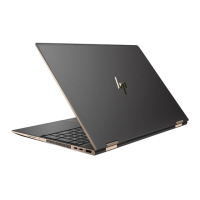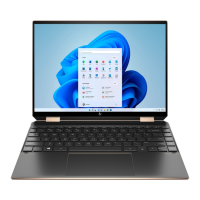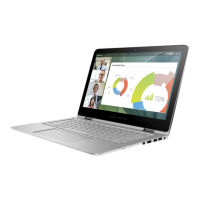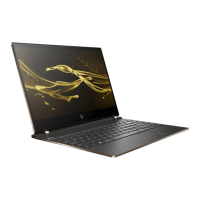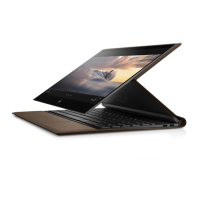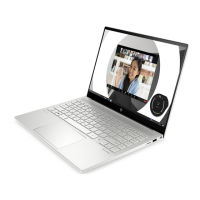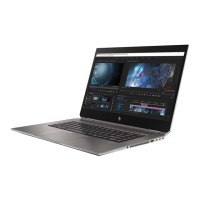
Do you have a question about the HP Spectre x360 and is the answer not in the manual?
| Form factor | Convertible (Folder) |
|---|---|
| Product type | Hybrid (2-in-1) |
| Product color | Silver |
| Country of origin | China |
| SSD capacity | The Solid State Drive's storage capacity in Gigabytes. |
| Storage media | SSD |
| Optical drive type | No |
| Card reader integrated | Yes |
| Total storage capacity | 256 GB |
| Compatible memory cards | SD |
| Number of SSDs installed | 1 |
| Display diagonal | 15.6 \ |
| Touch technology | Multi-touch |
| Native aspect ratio | 16:9 |
| Speakers manufacturer | Bang & Olufsen |
| Wi-Fi standards | Wi-Fi 5 (802.11ac) |
| Bluetooth version | 4.0 |
| Charging port type | DC-in jack |
| USB 2.0 ports quantity | USB 2.0 ports have a data transmission speed of 480 Mbps, and are backwards compatible with USB 1.1 ports. You can connect all kinds of peripheral devices to them. |
| Thunderbolt ports quantity | 0 |
| USB 3.2 Gen 1 (3.1 Gen 1) Type-A ports quantity | 3 |
| Power adapter depth | 134.87 mm |
| Power adapter width | 486.92 mm |
| Power adapter height | 357.89 mm |
| Power adapter weight | 3968.94 g |
| Battery capacity | 64.5 Wh |
| Pointing device | Touchpad |
| Internal memory | 8 GB |
| Memory clock speed | 1600 MHz |
| Memory form factor | On-board |
| Internal memory type | LPDDR3-SDRAM |
| On-board graphics card ID | 1916 |
| Discrete graphics card model | Not available |
| On-board graphics card model | Intel® HD Graphics 520 |
| On-board graphics card family | Intel® HD Graphics |
| Maximum on-board graphics card memory | 1.74 GB |
| On-board graphics card OpenGL version | 4.4 |
| On-board graphics card base frequency | 300 MHz |
| On-board graphics card DirectX version | 12.0 |
| On-board graphics card dynamic frequency (max) | 1000 MHz |
| Sustainability certificates | EPEAT Silver, ENERGY STAR |
| AC adapter power | 45 W |
| Bus type | QPI |
| Stepping | D1 |
| Tjunction | 100 °C |
| Processor cache | 3 MB |
| Processor cores | 2 |
| Processor model | i5-6200U |
| System bus rate | 4 GT/s |
| Processor family | Intel® Core™ i5 |
| Processor series | Intel Core i5-6200 series |
| Processor socket | LGA 1356 (Socket B2) |
| Processor codename | Skylake |
| Configurable TDP-up | 25 W |
| Processor frequency | 2.3 GHz |
| Processor cache type | Smart Cache |
| Configurable TDP-down | 7.5 W |
| Processor lithography | 14 nm |
| Processor manufacturer | Intel |
| Processor front side bus | - MHz |
| PCI Express slots version | 3.0 |
| Processor boost frequency | 2.8 GHz |
| Processor operating modes | 64-bit |
| PCI Express configurations | 1x4, 4x1 |
| Thermal Design Power (TDP) | 15 W |
| Configurable TDP-up frequency | 2.4 GHz |
| Configurable TDP-down frequency | 0.8 GHz |
| Maximum number of PCI Express lanes | 12 |
| Processor code | SR2EY |
| Processor ARK ID | 88193 |
| Processor package size | 42 X 24 mm |
| Supported instruction sets | SSE4.1, SSE4.2, AVX 2.0 |
| Intel Secure Key Technology version | 1.00 |
| Intel Stable Image Platform Program (SIPP) version | 0.00 |
| Depth | 247 mm |
|---|---|
| Width | 378 mm |
| Height | 16 mm |
| Weight | 1823.44 g |
Critical safety instructions to prevent overheating and heat-related injuries during computer operation.
Crucial warning about modifying processor settings in msconfig.exe for specific computer models.
Guide to accessing and downloading applications from the HP Apps Store for enhanced user experience.
Recommended steps after setup to maximize computer investment and usability.
Information on locating additional product details, guides, and support resources from HP.
Instructions on how to identify installed hardware components using Device Manager.
Guide to finding information about installed software applications on the computer.
Identification and description of components located on the right side of the computer.
Identification and description of components located on the left side of the computer.
Overview of display components including cameras, microphones, and lights.
Explanation of the TouchPad zone and its buttons for screen navigation.
Description of indicator lights like Caps Lock and Mute status.
Information about the computer's built-in speakers for audio output.
Identification of special keys like Esc, Fn, Windows, and Action keys.
Explanation of how to use function keys for various system operations.
Identification and description of components located on the bottom of the computer.
Information on locating and understanding various labels on the computer.
Guide to connecting via WLAN, Mobile Broadband, and Bluetooth.
Step-by-step instructions for establishing a wireless local area network connection.
Instructions for using built-in mobile broadband for internet connectivity.
How to enable and use Global Positioning System features for location services.
Guide to connecting and using Bluetooth-enabled devices wirelessly.
Instructions for connecting the computer to a network using a wired Ethernet cable.
Guide to using the computer's camera for video chat, recording, and more.
Information on playing music, downloading audio, and using audio devices.
Instructions for connecting wired or wireless speakers to the computer.
Guide to connecting wired or wireless headphones and safety precautions.
Instructions for connecting wired or wireless headsets and safety warnings.
How to adjust system volume, sounds, and manage audio devices.
Information on watching streaming video and connecting external display devices.
Steps for connecting external displays via a USB Type-C cable.
Guide to connecting to wireless displays using Miracast technology.
Explanation of basic touch gestures for navigating the computer screen.
How to use the tap gesture to select or open items on the screen.
Instructions for zooming using two fingers.
How to use the four-finger tap gesture.
Using keyboard and mouse for navigation.
Overview and manual control of Sleep and Hibernation states.
Using power meter, settings, and HP Fast Charge for battery management.
Running on battery, conserving power, and resolving low battery levels.
Safe methods for shutting down the computer and troubleshooting power issues.
Improving performance with Disk Defragmenter and Cleanup.
Updating software/drivers and safe cleaning procedures.
Tips for safely traveling with or shipping the computer.
Using passwords for Windows, BIOS, and Windows Hello.
Using security software, updates, and securing wireless networks.
Backing up applications and information, using security cables.
How to access and start the computer's BIOS setup utility.
Information on checking for and obtaining BIOS updates from the HP website.
Methods to find the current BIOS version for update checks.
Detailed steps for safely downloading and preparing a BIOS update.
Instructions for downloading diagnostic tools to a USB drive for hardware testing.
Methods for creating system recovery media and personal data backups.
Options and methods for restoring the computer to a previous state or factory settings.
Detailed guide on using HP Recovery Manager for system restoration.
How to perform system recovery using the dedicated recovery partition.
Steps to recover the system using created or obtained HP Recovery media.
Technical details about the computer's power requirements and ratings.
Specifications for temperature, humidity, and altitude for computer operation.
Information on assistive technologies supported by HP products for users with disabilities.
Contact information and methods for obtaining technical and accessibility support.

